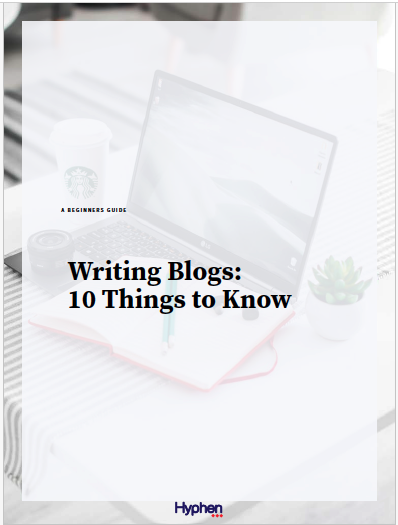Our small business clients often seek advice on how to write blogs. Many small businesses are told that blogs are essential to one’s website but are unsure how to develop an effective blog strategy. Without guidance, many don’t know where to start. This blog outlines the key elements of writing a blog, but to make it more useful to you, we created an eBook which you can download for easy reference. Click here for our eBook “Writing Blogs: 10 Things to Know.”
Why Write Blogs?
Let’s assume that your website does a good job of presenting your products or services clearly and in a compelling way. Your blog represents the updated content that demonstrates your company’s expertise. As fresh content, a blog signals to Google that you have something new, which helps with rankings and search results. In other words, it improves your website SEO (Search Engine Optimization) and website traffic. In short, a blog serves as further testimony that your company or organization is an expert in the field your target customer is seeking information about. So, the simple answer is to write a blog that speaks to your target customers and drives them to your website.
What Should I Write About?
Blogs’ subject matter should directly relate to your company's core competency. In all effective marketing, your brand positioning should inform your blog content. Ask yourself: how is your company uniquely different, what is your core expertise, who is your target audience, and what are their informational needs or desires?
Our eBook outlines specific ideas of how you can more easily create content… and it’s not by relying on AI, to give you a hint.
What is the ideal length of a blog?
This is the perennial question for bloggers. The answers span a wide range. Check out our eBook for some specific guidance.
How Should I Title the Blog?
Blog titles, just like book titles, are essential. Why? The obvious: it’s the first content that your potential reader sees. Google also captures the title as the primary headline, or H1, to drive search engine ranking.
So, your title should be catchy and include the researched focus keyword. Here is an article you may find helpful: “How to Write Catchy Headlines and Blog Titles Your Readers Can’t Resist.”
What are the Guidelines for Blog Copy?
There are two overarching guidelines for blog copy best practices.
First, the rules of good writing prevail.
Second, unless you are targeting a specialized audience, most readers today follow the acronym TL: DR – Too Long: Didn’t Read. That’s a shorthand notation added by an editor indicating that a passage appears too long to invest the time. Let’s dig into both ‘rules.’
The guidelines of good writing, which you likely covered in high school English class, apply to blog writing. Good writing is essential for readers and search engines. SEO plugins such as the Yoast evaluate a blog post or web page's readability, measuring those principles your English teacher taught you.
Check out our eBook for specific direction on writing and formatting a blog.
OK, how much do you think I should know about SEO?
While SEO seems intimidating to many, there are a few things you need to maximize the discoverability of your blogs. Remember, my suggestions above advise on best practices for making a blog more Google-friendly, including improving readability. In our eBook, we suggest explicit measures that will boost SEO.
What about the tone of your blog?
While businesses and organizations have different personas, a friendly tone is often the way to go. Make sure to write as though you are talking to a colleague. Being clever and engaging goes a long way in securing followers who want to read your blog. While I suggest using Chat GPT to a limited extent, original content is paramount. Your content should reflect the expertise that your company or organization owns! However, the tone must be appropriate for your audience and subject matter.
Where Should You Promote Your Blog?
The publication of a blog represents a marketing opportunity. This is the time to leverage your marketing channels—email, newsletters, social media, pop-ups - to alert your customers and prospects that there’s a new reason to visit your website. It’s the true and tried formula: tap your marketing channels with a tease about your new content and drive them to your website to read it. Website visits yield more impressions, and more interaction on your website generates more conversions. All good for business.
Any final suggestions?
Yes, subscribe to Grammarly. It’s the best software I have ever used. There is a free version, but its writing guidance and grammatical corrections add enormous value to any writing.
Reach out to us if you’d like to discuss your marketing strategy. Hyphen3 can help you with blogs and a lot more.










